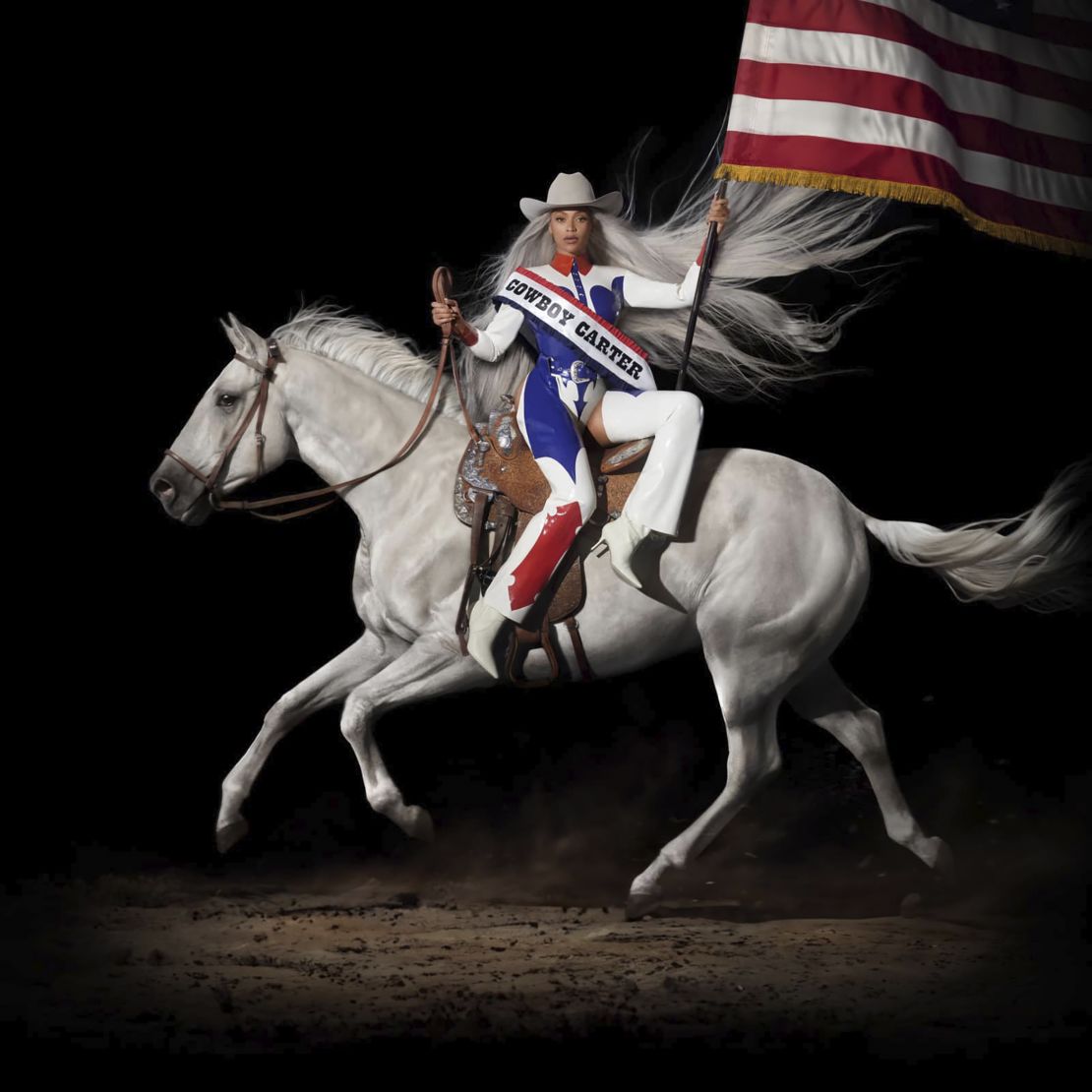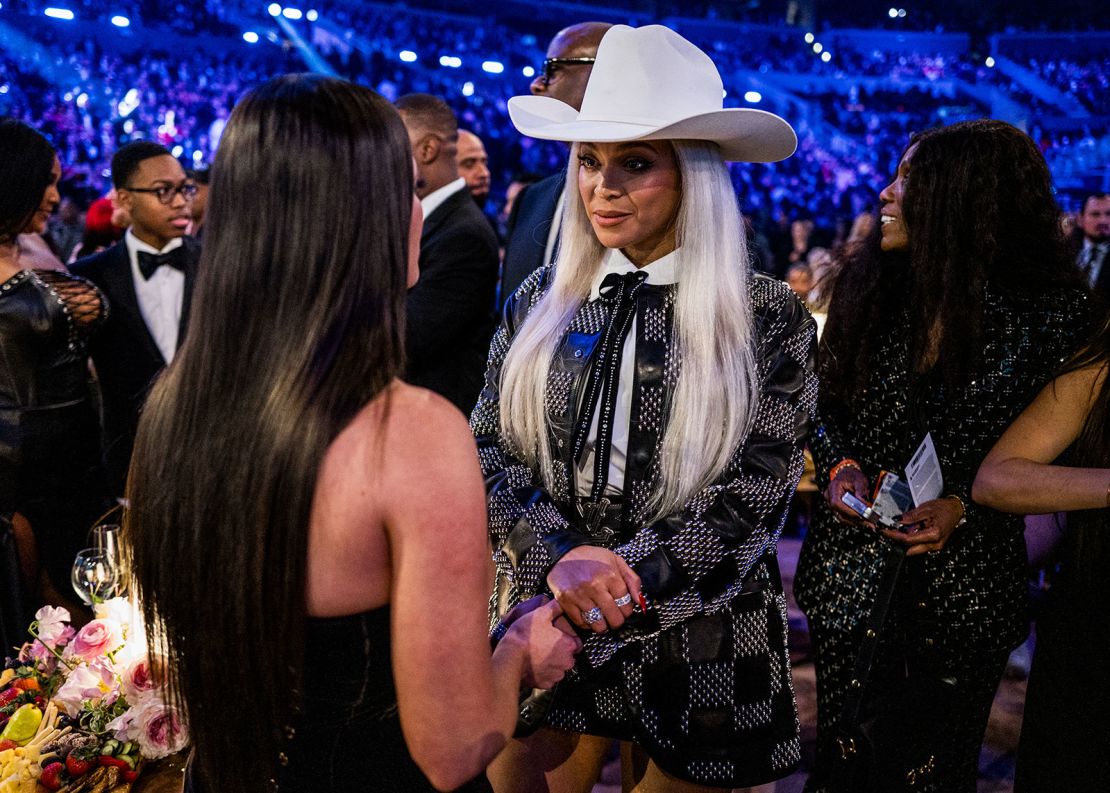The symbolism in Beyoncé’s ‘Cowboy Carter’ album has fans talking.
Beyoncé knows how to get people talking, and her new album “Cowboy Carter,” had tongues wagging long before its release date on March 29. With star power as ubiquitous as hers, every little detail of a new work is going to be embraced and dissected, especially since Beyoncé is also known for serving up enticingly intertextual visuals alongside her music.
It’s no wonder the art around her latest country project has already spawned deep socio-political discourse about American symbolism, Blackness, justice and reclamation.
“Cowboy Carter” is the much-anticipated followup to her 2022 album “Renaissance” and her 2016 album “Lemonade,” both of which injected the culture with paradigm-shifting art and symbolism. It also marks an official foray into country music, a space rich with meaning for a Black artist in sparse yet influential company.
Now that “Cowboy Carter” is finally coming to the masses, here are some of the conversations people are having about the music icon’s next big era.
The symbolism of the American flag
“Cowboy Carter’s” primary cover art contains a whole rodeo’s worth of American symbolism: Beyoncé, platinum hair billowing, enthroned on a galloping white horse. There’s leather, there are cowboy boots and a crisp white hat; there’s head-to-toe red, white and blue.
Then, there’s the massive American flag, held aloft in Beyoncé’s left hand. Some fans found it a curious symbol to leverage given Beyoncé’s historic support of racial justice movements and larger conversations about what the flag means to marginalized Americans.

One of the cover’s most vocal critics was artist Azaelia Banks, who is known for her lengthy cultural commentaries. On Instagram, Banks criticized the look as “white woman cosplay” and mentioned the racialized history of American patriotism.
Beyond Banks’ customary outspokenness, a notable group of Beyoncé fans levied similar critiques.
“I love her so much. I love everything about this project. It’s historical, provocative, subversive, and GOOD,” author Vanessa Vaillareal wrote on X. “But what does it mean to wave an American flag during a genocide? What does it mean to wave it as a Black woman? As a Texan?”
“The American flag has represented imperialism and violence in the global South for longer than any of us have been alive,” another fan wrote. “You can feel connected to your roots here without being draped in a symbol of oppression for the majority of the world.”
However, just as many Beyoncé fans took the flag to mean she was taking ownership of her Americanness. Tory Shulman, an art history expert and host on the YouTube news show Daily Blast Live, said Beyoncé was “reclaiming patriotism” with the image and compared it to paintings deifying famous leaders like Napoleon and George Washington.
Fans on social media also noted a remarkable 1975 conversation between literary legends James Baldwin and Maya Angelou where they discuss what it means to them to be Black and American.
“We are black Americans. We have our feet, our souls, our hearts [here],” Angelou says.
“We have paid for this country,” Baldwin adds, before laughingly adding, “That’s why I can never leave it, by the way.”
The reclamation of Black country identity
To many Black Texans and other Black Americans with country roots, Beyoncé’s flag-bearing, cowboy hat-wearing promenade communicated something completely different. People have pointed out the imagery pays homage to Black rodeo stars, specifically rodeo queens who carry the American flag after a victory.
Rodeo buffs also took the opportunity to reintroduce social media to Ja’Dayia Kursh, an Arkansan who became the state’s first Black rodeo queen in 2023.
“One thing we’ve learned from the discourse surrounding Beyoncé’s new cover art (& singles) is, most of y’all have no idea what Black American culture is,” one fan wrote on X. “You read our history in a book, but lack the understanding of the nuances of who we are. This is Black American culture.”
“Beyoncé’s album cover makes complete sense to Black Texans” guest columnist Taylor Crumpton wrote for Bloomberg.
“To be a Black Texan, you learn how to bear hatred and love in your heart at the same time … (Beyoncé’s) striving to communicate many things, of course, while also simply reminding all of us that Black cowboys and rodeo performers have been part of the social fabric of Texas, the South and the US for a very long time.”
Music artist and rodeo rider Randy Savvy also made a connection between the history of Black artists in country music and the history of Black cowboys and rodeo figures.
“In both realms, there is a rich tapestry of African-American influence that has been integral, yet not adequately explained,” he wrote in Los Angeles Magazine.
Racism within the country music industry and beyond
In an Instagram post describing the creative process behind “Cowboy Carter,” Beyoncé said a negative experience with the country music crowd led her to “a deeper dive into the history of Country music and … our rich musical archive.” A Houston native, Beyoncé herself has never been shy about her roots, and notably crossed over to country with her 2016 song “Daddy Lessons.”

This theme of uncovering Blackness in country spaces continues in the art for the album’s track list: Styled in bold fonts and colors, the track list features the line “Cowboy Carter and the rodeo chitlin’ circuit” above the track names cascading in banner-like shapes.
The Chitlin’ Circuit, many have pointed out, was a series of music venues that allowed Black performers in the Jim Crow South, and even the design of the tracklist echoes posters from that era. (“Chitlins,” also called chitterlings, is a dish of animal intestines with roots in the American South and specifically among enslaved people there.)
To show how even the design of a track list can make a huge impact (at least, when the artist in question is Beyoncé), the country music site “Wide Open Country” published an explanation of the Chitlin’ Circuit — a sure sign that, whether country critics like it or not, Beyoncé’s genre shift is generating real interest.
Among the 27 titles listed on the album, one in particular also calls to an important figure in Black country. “The Linda Martell Show” is named after Linda Martell, the first Black woman to perform at the Grand Ole Opry in 1969. Like the Chitlin’ Circuit, a reference to Linda Martell is as much about racism as it is Black achievement: Martell left the country world only a few years into her rising career due to prejudice and abuse.
Of course, a new Beyoncé album is bound to ignite all sorts of conversations. Given how much her “Renaissance” aesthetic influenced fashion, people are already predicting rodeo queen-style sashes and glamorous cowboy hats could be the next trends to benefit from her influence.
However, fans know that a Beyoncé album isn’t just about looks; it’s a whole presentation, complete with citations and parallels and deep cuts into lesser-known areas of history. The discourse is part of the experience as much as any cowboy hat, and “Cowboy Carter” is already taking fans to school.
Credit: Source link